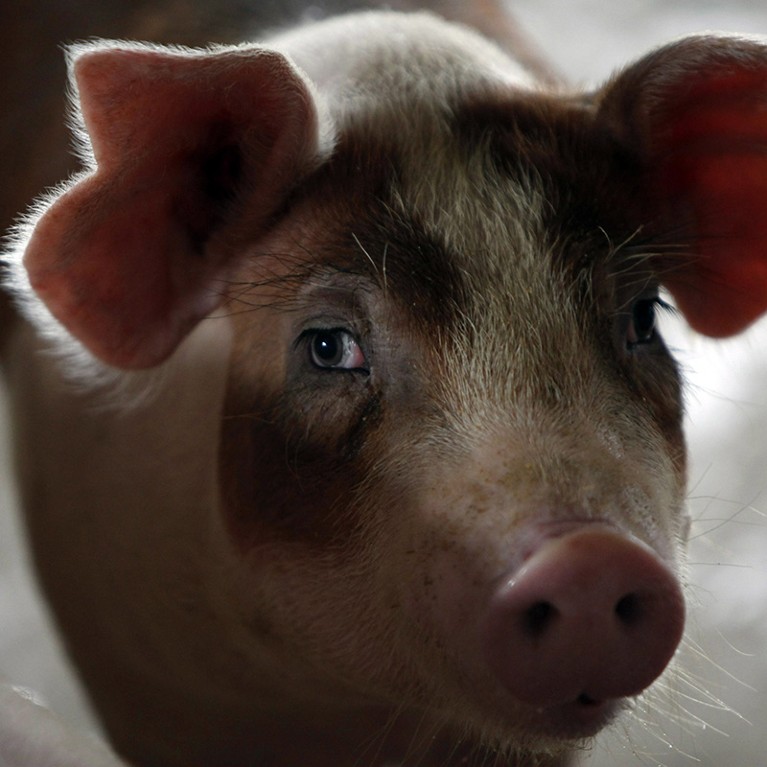Hello Nature readers, would you like to get this Briefing in your inbox free every day? Sign up here.

The pigs whose brains were used in the study had been killed at a slaughterhouse for meat.Credit: Chaiwat Subprasom/Reuters
Pig brains kept alive outside body for hours after death
“For most of human history, death was very simple. Now, we have to question what is irreversible.”
Researchers have revived the disembodied brains of pigs four hours post-mortem, and kept them alive for up to 36 hours. The organs, removed after the animals had been slaughtered for food, were hooked up to a system called BrainEx, which pumped in a blood substitute containing nutrients, oxygen and chemicals that stop neurons from firing. By doing so, the scientists were able to restore some crucial functions, such as cells’ ability to produce energy and remove waste. But the team never saw coordinated electrical patterns across the entire brain, which would indicate sophisticated brain activity. If they had spotted signs that an organ was regaining consciousness, they were ready to administer anaesthetics.
The research raises a host of ethical questions, from animal welfare to the definition of consciousness. It also has implications for human organ donation, and the criteria around when patients are declared dead.
Keep an eye out for our follow-up article where we’ll be answering readers’ questions about this groundbreaking work.
Read more in these Comment pieces:
Part-revived pig brains raise slew of ethical quandaries
Pig experiment challenges assumptions around brain damage in people
Prominent geneticist freed from prison as dictator ousted
Muntaser Ibrahim, a leading geneticist, has been freed from prison in Sudan alongside hundreds of other civilians, including academics, who were detained in recent months for protesting against the regime of now-toppled dictator Omar al-Bashir. Their release was ordered last week by the army, which ousted al-Bashir on 11 April.
Gene therapy frees ‘bubble-boy’ babies from a life of isolation
An experimental gene therapy has restored functioning immune systems to eight young children with a severe genetic disorder that would have sentenced them to a life of isolation to avoid potentially deadly infections. The children suffered from X-linked severe combined immunodeficiency (SCID-X1), and the therapy replaced the mutated gene that causes the disease with a correct copy. Scientists used a disabled virus related to HIV to deliver the gene. Researchers have been working for decades to find a way to treat the condition, and this is the closest they’ve come to a cure. The children will be monitored carefully for years, to check that their immune systems remain stable.
Reference: The New England Journal of Medicine paper
‘Friendly’ reviewers rate grant applications more highly
When grant applicants are allowed to recommend referees for their applications, the resulting appraisals are four times more likely to be rated as "excellent" or "outstanding" than "poor" or "good". The finding from the Swiss National Science Foundation, which examined more than 38,000 reviews, prompted the funder to swiftly ban grant applicants from being able to nominate referees.
FEATURES & OPINION

Credit: Marcel Kusch/AFP/Getty
Lightning’s striking structure
A huge radio telescope is giving scientists an unprecedented view of the 3D structure of lightning, revealing intriguing needle-like tendrils up to 100 metres long.
The most political animal
Wolves are returning to countries across Europe. In Norway, “humans have greeted the returning wolves with both great joy and exceptionally furious resistance”, opening up a fevered political dispute between urban and rural communities.
Lifting the lid on peer review
Peer review is hard, time-consuming and often, it seems, thankless. In 2016, a number of Nature Research journals introduced a trial to bring some transparency and recognition to the process, giving authors the option to thank reviewers, and reviewers the option to be named on the published paper. Over the 3-year trial, around 3,700 referees chose to be publicly recognized and around 80% of Nature papers have at least one referee named.
SPRING BOOKS

Illustration by Ana Kova
“We think of science as enacted by these lone stars. But the lone stars are really part of a constellation.”
Nature’s Books and Arts Editor Barb Kiser brings you a wonderful collection of volumes in our Spring Books special:
• You’ll have heard of Francis, Crick, Wilkins and Franklin. But there are many other half-obscured scientists who paved the way to the double helix.
• An ongoing, often fervid debate over the direction of theoretical physics pivots on the relationship between physics and mathematics. Has maths become too dominant?
• Thomas Harriot was one of the founders of modern science — but you’ve probably never heard of him.
• If the world is going to hell in a handbasket, Jared Diamond has not given up hope that we can change course, exploring seven nations that survived apocalypse.
• Twentieth-century psychiatry saw a struggle for supremacy between biologists, psychoanalysts and sociologists. The field has a painful history at the nexus of mental illness and biology.
• In 1916, Albert Einstein published his general theory of relativity. Three new books explore those who worked to confirm his radical new theory, and its subsequent ramifications for cosmology and astrophysics.
